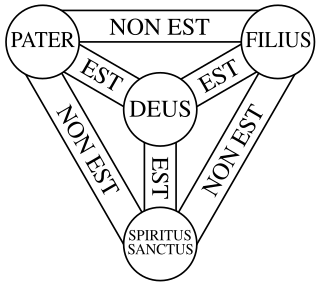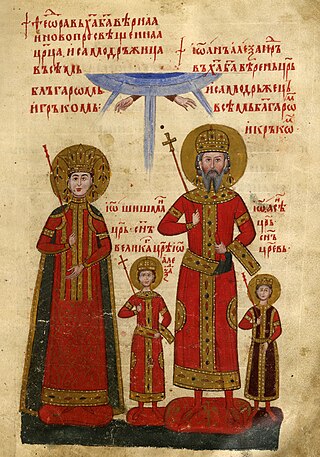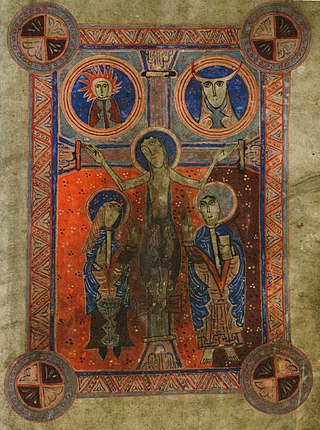
Vincent of Beauvais was a Dominican friar at the Cistercian monastery of Royaumont Abbey, France. He is known mostly for his Speculum Maius, a major work of compilation that was widely read in the Middle Ages. Often retroactively described as an encyclopedia or as a florilegium, his text exists as a core example of brief compendiums produced in medieval Europe.

The Morgan Bible, also called the Morgan Picture Bible, Crusader Bible, Shah Abbas Bible or Maciejowski Bible, is a unique medieval illuminated manuscript. It is a picture book Bible consisting of 46 surviving folios. The book consists of miniature paintings of events from the Hebrew Bible, set in the scenery and costumes of thirteenth-century France, and depicted from a Christian perspective. It is not a complete Bible, as it consists largely of illustrations of stories of kings, especially King David. The illustrations are now surrounded by text in three scripts and five languages: Latin, Persian, Arabic, Judeo-Persian, and Hebrew. The level of detail in the images and the remarkable state of preservation of the work make it particularly valuable to scholars.

The Limbourg brothers were Dutch miniature painters from the city of Nijmegen. They were active in the early 15th century in France and Burgundy, working in the International Gothic style.
In the Western Church of the Early and High Middle Ages, a sacramentary was a book used for liturgical services and the mass by a bishop or priest. Sacramentaries include only the words spoken or sung by him, unlike the missals of later centuries that include all the texts of the mass whether read by the bishop, priest, or others. Also, sacramentaries, unlike missals, include texts for services other than the mass such as ordinations, the consecration of a church or altar, exorcisms, and blessings, all of which were later included in Pontificals and Rituals instead.

The Cathedral of Saint Peter of Beauvais is a Roman Catholic church in the northern town of Beauvais, Oise, France. It is the seat of the Bishop of Beauvais, Noyon and Senlis.

The Shield of the Trinity or Scutum Fidei is a traditional Christian visual symbol which expresses many aspects of the doctrine of the Trinity, summarizing the first part of the Athanasian Creed in a compact diagram. In late medieval Europe, this emblem was considered to be the heraldic arms of God.

The Stowe Missal, which is, strictly speaking, a sacramentary rather than a missal, is a small Irish illuminated manuscript written mainly in Latin with some Old Irish in the late eighth or early ninth century, probably after 792. In the mid-11th century, it was annotated and some pages rewritten at Lorrha Monastery in County Tipperary, Ireland. Between 1026 and 1033 the manuscript was encased within a protective cumdach, which was refurbished and embellished a number of times in the late medieval period, in particular before 1381, the year of death of Pilib O'Ceinneidigh, Lord of Ormond, who then had possession of the shrine.

The Gospels of Tsar Ivan Alexander, Tetraevangelia of Ivan Alexander, or Four Gospels of Ivan Alexander is an illuminated manuscript Gospel Book, written and illustrated in 1355–1356 for Tsar Ivan Alexander of the Second Bulgarian Empire. The manuscript is regarded as one of the most important manuscripts of medieval Bulgarian culture, and has been described as "the most celebrated work of art produced in Bulgaria before it fell to the Turks in 1393".
Otto F. Ege (1888–1951) was a teacher, lecturer, bookseller, and well-known book-breaker. He worked for many years at the Cleveland Institute of Art where he served as Chair of the Department of Teacher Training, instructor of Lettering, Layout, and Typography, and Dean. He was also employed by the School of Library Science at Case Western Reserve University as a lecturer on the History of the Book, and instructor of History and Art of the Book.

Commentary on the Apocalypse is a book written in the eighth century by the Spanish monk and theologian Beatus of Liébana (730–785) and copied and illustrated in manuscript in works called "Beati" during the 10th and 11th centuries AD. It is a commentary on the New Testament Apocalypse of John or Book of Revelation. It also refers to any manuscript copy of this work, especially any of the 27 illuminated copies that have survived. It is often referred to simply as the Beatus. The historical significance of the Commentary is made even more pronounced since it included a world map, which offers a rare insight into the geographical understanding of the post-Roman world. Well-known copies include the Morgan, the Saint-Sever, the Gerona, the Osma and the Madrid Beatus codices.

The Sherborne Missal is an early 15th-century English illuminated manuscript missal, one of the finest English examples of International Gothic painting. With 347 vellum leaves measuring 535 by 380 millimetres, it weighs 20 kg. It has survived in excellent condition, and is usually on display at the Ritblat Gallery in the British Library. It has been described as "beyond question the most spectacular service book of English execution to have come down to us from the later Middle Ages."

Peronet Lamy, called Perenet lenlumineur, was a Gothic painter and manuscript illuminator who spent his career in the employ of the House of Savoy.
The Stowe manuscripts are a collection of about two thousand Irish, Anglo-Saxon and later medieval manuscripts, nearly all now in the British Library. The manuscripts date from 1154 to the end of the 14th century.
Janet Moira Backhouse was an English manuscripts curator at the British Museum, and a leading authority in the field of illuminated manuscripts.

The Leofric Missal is an illuminated manuscript, not strictly a conventional missal, from the 10th and 11th century, now in the Bodleian Library at Oxford University where it is catalogued as MS Bodl. 579.

The Black Hours, MS M.493 is an illuminated book of hours completed in Bruges between 1460 and 1475. It consists of 121 pages (leaves), with Latin text written in Gothic minuscule script. The words are arranged in rows of fourteen lines and follow the Roman version of the texts. The lettering is inscribed in silver and gold and placed within borders ornamented with flowers, foliage and grotesques, on pages dyed a deep blueish black. It contains fourteen full-page miniatures and opens with the months of the liturgical calendar, followed by the Hours of the Virgin, and ends with the Office of the Dead.
The Bobbio Missal is a seventh-century Christian liturgical codex that probably originated in France.

The Skara Missal is a 12th-century illuminated manuscript, a missal kept in Stifts- och landsbiblioteket i Skara, a library in Skara, Sweden. It is the oldest surviving missal of this kind in Scandinavia. It is written in Latin, and is in folio format. Only about one eighth of the original remains, or 44 pages. The book was originally bound in a single volume, but is since the 13th or 14th century split into two volumes. One of the volumes is currently part of the permanent exhibition of Västergötland Museum. It was written by two different scribes. It contains text, illuminations and musical notes. The illuminations consist of two full page illustrations, four large decorative initials and a number of smaller ones. Certain traits indicate that the illuminator may have come from Scandinavia.

Fragmentology is the study of surviving fragments of manuscripts. A manuscript fragment may consist of whole or partial leaves, typically made of parchment, conjugate pairs or sometimes gatherings of a parchment book or codex, or parts of single-leaf documents such as notarial acts. They are commonly found in book bindings, especially printed books from the 15th to the 17th centuries, used in a variety of ways such as wrappers or covers for the book, as endpapers, or cut into pieces and used to reinforce the binding. In other non-Western manuscript cultures, fragments of paper manuscripts and other materials, takes place beside parchment, including board covers that many times reused written paper.

Fragmentarium is an online database to collect and collate fragments of medieval manuscripts making them available to researchers, collectors and historians worldwide. It is an international collaboration of major libraries and collections including the British Library, Bibliothèque nationale de France, Martin Schøyen Collection, Bavarian State Library, Harvard, Yale and the Vatican. It is based in Switzerland and the project's current director is Professor Christoph Flüeler from the University of Fribourg and the Virtual Manuscript Library, Switzerland.















